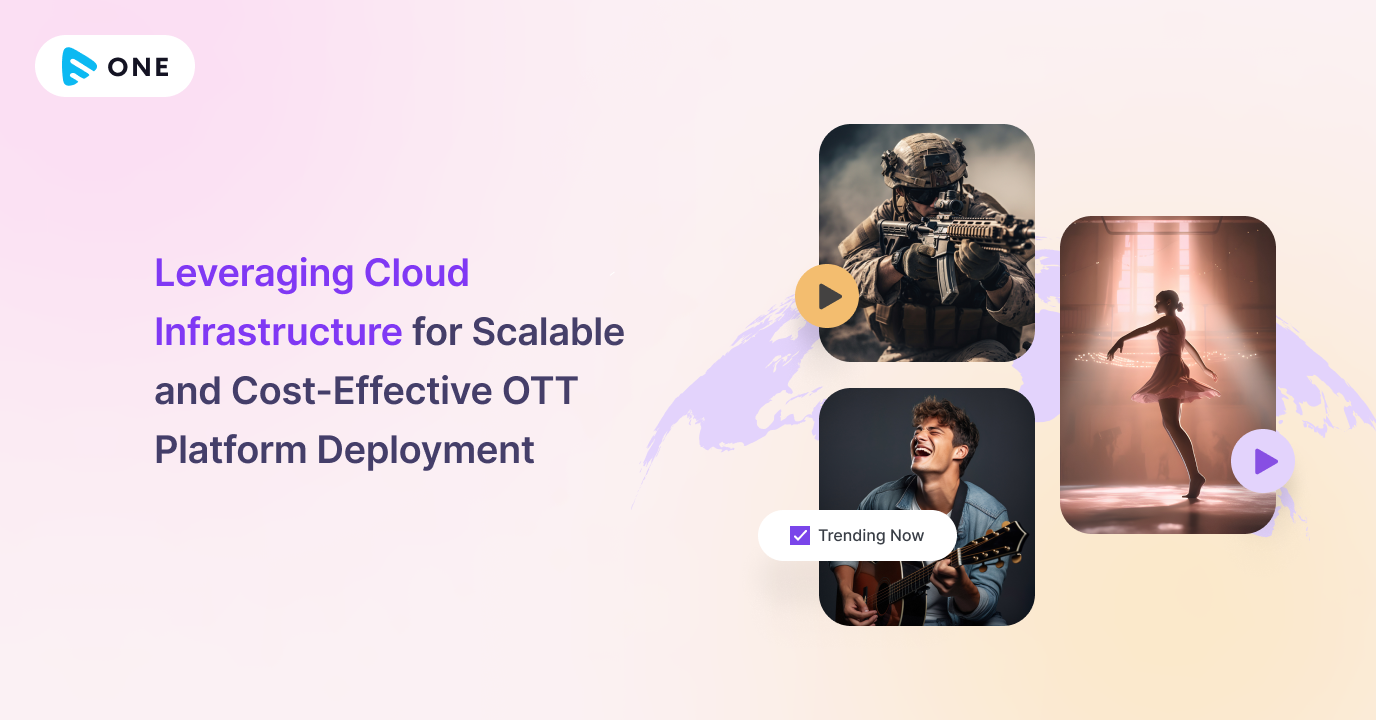Have you ever wondered how to manage to handle millions of concurrent viewers without crashing?
Well, the answer lies in leveraging cloud OTT infrastructure for scalable and cost-effective platform deployment.
Cloud OTT infrastructure offers unparalleled scalability, allowing streaming platforms to dynamically scale resources up or down based on demand. Whether it’s during peak viewing hours or for live events with high audience engagement, cloud infrastructure enables seamless scalability to accommodate any number of concurrent viewers without compromising performance.
Furthermore, utilizing cloud infrastructure for OTT platform deployment is cost-effective, as it eliminates the need for upfront hardware investments and provides flexible pricing models based on usage.
This allows streaming businesses to pay only for the resources they consume, reducing operational costs while maintaining optimal performance and reliability. Wondering why and how it’s relevant for your OTT business? Read on, as we cover everything for you.
Why Is Cloud Infrastructure Relevant in OTT?
Cloud infrastructure plays a significant role in the success of OTT streaming platforms for various reasons, making it a highly relevant and essential component of the industry. Here’s why:
1. High Scalability
Cloud infrastructure offers unparalleled scalability, allowing OTT platforms to seamlessly accommodate fluctuations in viewership and demand. Whether there’s a sudden surge in viewers during popular events or a steady increase in subscribers over time, cloud-based solutions enable streaming services to scale resources up or down as needed, ensuring optimal performance without the need for additional hardware investments.
2. Cost-Effectiveness
It provides cost-effective solutions for OTT platforms by eliminating the need for upfront hardware investments and offering flexible pricing models based on usage. Streaming services can pay only for the resources they consume, reducing operational costs while maintaining high performance and reliability. This cost-effectiveness allows OTT platforms to allocate resources efficiently and invest in other areas of growth and innovation.
3. Global Reach
Cloud infrastructure enables OTT platforms to reach global audiences without geographical limitations. By leveraging cloud-based solutions, streaming services can distribute content efficiently to viewers worldwide, regardless of their location. This global reach expands the audience base and revenue potential for OTT platforms, driving growth and expansion into new markets.
4. Reliability and Redundancy
Cloud infrastructure offers high levels of reliability and redundancy, ensuring uninterrupted service availability for OTT platforms. With built-in redundancy measures and failover mechanisms, cloud-based solutions minimize the risk of downtime and service disruptions, providing a seamless viewing experience for users. This reliability is crucial for maintaining viewer satisfaction and loyalty in the competitive OTT industry.
5. Agility and Innovation
It empowers OTT platforms with agility and innovation, allowing them to adapt quickly to changing market trends and technological advancements. With cloud-based solutions, streaming services can experiment with new features, launch innovative services, and iterate on their offerings rapidly, staying ahead of the competition and meeting evolving viewer demands.
Utilizing Cloud Infrastructure for a Scalable and Cost-Effective OTT Platform Development
1. Scalability Through Virtualization
One of the key advantages of cloud infrastructure for OTT platform development is its inherent scalability through virtualization. Virtualization technology enables the creation of virtual instances of computing resources, such as virtual servers, storage, and networks, within a cloud environment. This allows OTT platforms to dynamically scale resources up or down based on demand, ensuring optimal performance and reliability during peak usage periods or sudden traffic spikes.
By leveraging virtualization, OTT platforms can automatically provision additional resources in real-time to handle increased viewership or demand for content. This scalability is essential for accommodating fluctuations in audience size, ensuring that viewers receive uninterrupted access to streaming content without performance degradation or downtime.
2. Cost-Effective Resource Allocation
Cloud infrastructure offers cost-effective resource allocation for OTT platform development, enabling businesses to optimize their spending and allocate resources efficiently. Unlike traditional on-premises infrastructure, cloud-based solutions eliminate the need for upfront hardware investments and provide flexible pricing models based on usage.
With pay-as-you-go pricing, OTT platforms only pay for the computing resources they consume, allowing them to scale resources up or down as needed without overprovisioning or underutilization. This cost-effective model reduces operational expenses and capital expenditures, freeing up resources to invest in content acquisition, platform enhancements, and business growth initiatives.
Additionally, cloud infrastructure enables OTT platforms to leverage economies of scale and benefit from the purchasing power of cloud providers. By pooling resources with other customers on shared infrastructure, OTT platforms can access high-performance computing resources at lower costs compared to building and maintaining their own data centers.
3. Optimizing Data Storage Solutions
Data storage is a critical component of OTT platform development, as streaming services must store and deliver vast amounts of multimedia content to viewers worldwide. Cloud infrastructure offers a range of data storage solutions optimized for scalability, reliability, and performance, allowing OTT platforms to efficiently manage their content libraries and deliver seamless streaming experiences.
Object storage services, such as Amazon S3 (Simple Storage Service) or Google Cloud Storage, provide scalable and durable storage solutions for storing media assets, such as videos, images, and audio files. These services offer high availability, data redundancy, and geo-replication capabilities, ensuring that content is accessible to viewers from any location with minimal latency.
Furthermore, cloud-based content delivery networks (CDNs) enhance the performance and reliability of OTT platforms by caching and delivering content from edge locations closer to viewers. CDNs reduce latency, improve streaming quality, and mitigate network congestion, resulting in smoother playback experiences for viewers across different devices and locations.
4. Streamlining Content Delivery Networks (CDNs)
Content Delivery Networks (CDNs) play a crucial role in optimizing the delivery of content to end-users, ensuring fast and reliable streaming experiences. By strategically distributing content across a network of servers located in various geographic regions, CDNs reduce latency and bandwidth constraints, resulting in improved performance and quality of service for OTT platforms.
- Geographic Distribution: CDNs leverage a distributed network of servers located in strategic geographic locations worldwide. This geographic distribution ensures that content is delivered from servers closest to the end-users, minimizing latency and reducing the time it takes for content to reach viewers. By reducing the distance between the server and the viewer, CDNs optimize content delivery speed and improve streaming performance.
- Edge Caching: CDNs utilize edge caching to store copies of content closer to end-users at edge server locations. When a user requests content, the CDN delivers it from the nearest edge server rather than the origin server, reducing the load on the origin server and improving content delivery speed. Edge caching also enhances scalability and reliability by offloading traffic from the origin server and distributing it across multiple edge servers.
- Dynamic Content Delivery: CDNs support dynamic content delivery by dynamically routing requests to the most optimal server based on network conditions, server availability, and content popularity. This dynamic routing ensures that viewers receive content from the fastest and most reliable server, enhancing the overall streaming experience. Additionally, CDNs can optimize content delivery in real-time by adjusting caching policies and routing rules to adapt to changing network conditions and viewer demand.
- Load Balancing: CDNs employ load balancing techniques to evenly distribute incoming traffic across multiple servers, ensuring optimal resource utilization and preventing server overload. By intelligently distributing traffic based on server capacity and performance metrics, load balancers improve the scalability, reliability, and availability of OTT platforms. Load balancing also enhances fault tolerance by automatically rerouting traffic away from failed or overloaded servers, minimizing downtime and service disruptions.
5. Leveraging Serverless Computing Models
Serverless computing models offer a scalable and cost-effective approach to deploying and managing applications in the cloud. By abstracting away the underlying infrastructure and handling server management tasks automatically, serverless computing enables OTT platforms to focus on building and deploying applications without worrying about server provisioning, scaling, or maintenance.
- Event-Driven Architecture: Serverless computing is based on an event-driven architecture, where functions are triggered by events such as HTTP requests, database changes, or scheduled tasks. This event-driven model allows OTT platforms to execute code in response to specific events without the need to provision or manage servers manually. By leveraging serverless functions, OTT platforms can build highly scalable and responsive applications that can handle sudden spikes in traffic or demand.
- Pay-Per-Use Pricing: Such models offer a pay-per-use pricing model, where users are charged only for the compute resources consumed by their functions. This pricing model eliminates the need for upfront infrastructure investments and allows OTT platforms to scale their applications automatically in response to changing workload demands. By paying only for the resources used, OTT platforms can optimize costs and reduce operational expenses, particularly during periods of low or fluctuating traffic.
- Automated Scaling: Serverless computing platforms such as AWS Lambda and Google Cloud Functions automatically scale resources up or down based on workload demand. This automated scaling eliminates the need for manual intervention and ensures that OTT platforms can handle sudden spikes in traffic without provisioning additional servers or resources. By dynamically adjusting resource allocation in real-time, serverless computing models optimize performance, scalability, and cost-effectiveness for OTT platforms.
6. Ensuring High Availability
High availability is essential for OTT platforms to deliver uninterrupted streaming experiences to viewers worldwide. By implementing robust high availability strategies, OTT platforms can minimize downtime, prevent service disruptions, and maintain reliable access to content for viewers.
- Redundant Architecture: High availability architectures leverage redundant components and failover mechanisms to ensure continuous service availability. OTT platforms deploy multiple instances of critical components such as servers, databases, and networking infrastructure across geographically distributed regions to minimize the impact of failures or outages. Redundant architectures also incorporate automated failover mechanisms that automatically route traffic away from failed components to healthy ones, minimizing downtime and ensuring uninterrupted service availability.
- Load Balancing: Load balancing plays a critical role in ensuring high availability by evenly distributing incoming traffic across multiple servers or instances. By distributing traffic across redundant components, load balancers prevent overloading and ensure optimal resource utilization, minimizing the risk of service degradation or downtime. Additionally, load balancers continuously monitor the health and performance of backend servers and automatically reroute traffic away from failed or unhealthy instances, ensuring continuous service availability for viewers.
- Multi-Region Deployment: OTT platforms deploy their applications and infrastructure across multiple geographic regions to ensure redundancy and fault tolerance. By distributing content delivery infrastructure across multiple regions, OTT platforms minimize the risk of regional outages or disruptions and ensure reliable access to content for viewers worldwide. Multi-region deployment also improves performance by reducing latency and optimizing content delivery speed for viewers in different regions.
7. Implementing Auto-scaling Mechanisms
Auto-scaling mechanisms enable OTT platforms to dynamically adjust resource allocation in response to changing workload demands, ensuring optimal performance and cost-effectiveness. By automatically scaling resources up or down based on predefined metrics or thresholds, auto-scaling mechanisms enable OTT platforms to handle sudden spikes in traffic or demand without manual intervention.
- Elastic Scaling: Auto-scaling mechanisms enable OTT platforms to scale resources elastically in real-time based on workload demand. By monitoring key performance metrics such as CPU utilization, memory usage, or incoming request rates, auto-scaling mechanisms automatically adjust resource allocation to match workload requirements. For example, during periods of high traffic or demand, auto-scaling mechanisms can provision additional servers or resources to handle the increased workload, ensuring optimal performance and availability for viewers.
- Scheduled Scaling: OTT platforms can implement scheduled scaling to anticipate changes in workload demand and proactively adjust resource allocation accordingly. By defining scaling policies or schedules based on predictable patterns or events, OTT platforms can automatically scale resources up or down at specific times or intervals. For example, OTT platforms can scale resources up before the start of a popular live event or scale resources down during periods of low traffic or demand, optimizing resource utilization and cost-effectiveness.
- Event-Driven Scaling: Auto-scaling mechanisms can be triggered by specific events or conditions, such as spikes in traffic, increases in request rates, or changes in resource utilization. By defining scaling policies based on event triggers or thresholds, OTT platforms can automatically scale resources in response to dynamic workload conditions. For example, OTT platforms can scale resources up when CPU utilization exceeds a certain threshold or scale resources down when incoming request rates decrease below a predefined level, ensuring optimal resource allocation and performance in real-time.
8. Security Considerations and Best Practices
Security is paramount for OTT platforms to protect user data, content integrity, and platform infrastructure from various threats. Implementing robust security measures and best practices is essential to safeguard against cyberattacks and unauthorized access.
- Data Encryption: Encrypting data in transit and at rest using industry-standard encryption algorithms ensures that sensitive information remains secure and protected from interception or unauthorized access.
- Access Control: Implementing granular access controls and role-based permissions helps restrict access to sensitive data and platform functionalities, ensuring that only authorized users can access and modify critical resources.
- Content Protection: Implementing digital rights management (DRM) solutions and content encryption techniques helps prevent unauthorized copying, distribution, and piracy of copyrighted content, safeguarding content integrity and intellectual property rights.
- Network Security: Deploying firewalls, intrusion detection and prevention systems (IDPS), and network segmentation techniques helps detect and mitigate malicious activities, such as DDoS attacks, malware infections, and network intrusions, protecting the platform infrastructure from security breaches and disruptions.
- Regular Security Audits: Conducting regular security audits and penetration testing helps identify vulnerabilities and weaknesses in the platform’s security posture, enabling proactive remediation and strengthening of security defenses against emerging threats.
9. Real-Time Analytics Implementation
Real-time analytics provide valuable insights into user behavior, content consumption patterns, and platform performance, enabling OTT platforms to make data-driven decisions and optimize user experience. Implementing real-time analytics offers several benefits:
- Audience Engagement: Real-time analytics track user engagement metrics, such as viewer retention, watch time, and interaction rates, providing insights into audience preferences and content preferences. By analyzing real-time engagement data, OTT platforms can tailor content recommendations, personalize user experiences, and improve audience engagement and retention.
- Content Performance: Real-time analytics measure content performance metrics, such as views, likes, shares, and comments, enabling OTT platforms to identify popular content, trends, and audience preferences. By analyzing real-time content performance data, OTT platforms can optimize content discovery, production, and distribution strategies to maximize viewer satisfaction and content effectiveness.
- Platform Health Monitoring: Real-time analytics monitor platform performance metrics, such as server response times, error rates, and uptime, providing insights into infrastructure health and performance. By monitoring real-time platform health data, OTT platforms can identify and address performance issues, bottlenecks, and failures proactively, minimizing downtime and ensuring optimal platform performance and reliability.
- Revenue Optimization: Real-time analytics track revenue metrics, such as ad impressions, click-through rates, and subscription conversions, enabling OTT platforms to optimize monetization strategies and maximize revenue generation. By analyzing real-time revenue data, OTT platforms can identify revenue opportunities, optimize pricing models, and implement targeted advertising and subscription campaigns to increase revenue and profitability.
10. Disaster Recovery Strategies
Disaster recovery strategies are essential for OTT platforms to minimize downtime, mitigate data loss, and ensure business continuity in the event of unforeseen disasters or disruptions. Implementing robust disaster recovery strategies offers several benefits:
- Data Backup and Replication: Implementing regular data backup and replication processes ensures that critical data and content assets are securely backed up and replicated to off-site locations or secondary data centers. By maintaining redundant copies of data, OTT platforms can mitigate the risk of data loss and recover quickly from hardware failures, data corruption, or malicious attacks.
- Failover and Redundancy: Implementing failover mechanisms and redundant infrastructure components helps minimize downtime and service disruptions by automatically redirecting traffic to secondary systems or backup servers in the event of hardware failures or outages. By maintaining redundant infrastructure components, OTT platforms can ensure high availability and reliability, even during unforeseen disasters or disruptions.
- Disaster Recovery Planning: Developing comprehensive disaster recovery plans and procedures helps OTT platforms prepare for and respond to various disaster scenarios effectively. By documenting disaster recovery plans, defining roles and responsibilities, and conducting regular drills and simulations, OTT platforms can ensure that staff are well-trained and equipped to respond to disasters quickly and effectively, minimizing downtime and maximizing recovery efforts.
- Cloud-Based Disaster Recovery: Leveraging cloud-based disaster recovery solutions offers flexibility, scalability, and cost-effectiveness, enabling OTT platforms to replicate critical data and infrastructure components to cloud-based environments. By leveraging cloud-based disaster recovery solutions, OTT platforms can reduce capital expenses, simplify management, and improve recovery time objectives (RTOs) and recovery point objectives (RPOs), ensuring rapid and reliable disaster recovery capabilities.
11. Multi-Region Deployment Options
Multi-region deployment options enable OTT platforms to deploy their applications and infrastructure across multiple geographic regions, ensuring redundancy, fault tolerance, and improved performance for viewers worldwide. Here are some common multi-region deployment options used in OTT platforms:
- Active-Active Deployment: Active-active deployment involves deploying identical copies of the application and infrastructure in multiple geographic regions simultaneously. Each region operates independently and serves live traffic, allowing for seamless failover and load balancing across regions. Active-active deployment ensures high availability, fault tolerance, and scalability by distributing traffic evenly across multiple regions and automatically rerouting traffic in the event of failures or outages.
- Active-Passive Deployment: Active-passive deployment involves deploying a primary or active instance of the application and infrastructure in one region, with one or more standby or passive instances in other regions. The passive instances remain inactive until needed, serving as backups in case of failures or outages in the primary region. Active-passive deployment provides redundancy and disaster recovery capabilities, allowing for quick failover to standby instances in the event of regional failures or disruptions.
- Global Load Balancing: Global load balancing distributes incoming traffic across multiple geographic regions based on proximity, latency, or availability. Global load balancers route traffic to the nearest or healthiest region, ensuring optimal performance and availability for viewers worldwide. By dynamically adjusting traffic routing based on real-time conditions, global load balancing improves scalability, fault tolerance, and user experience for OTT platforms operating in multiple regions.
Summing Up
No doubt that cloud infrastructure represents the future of OTT streaming, offering unparalleled scalability, security, and innovation opportunities for businesses in the digital entertainment industry. As the demand for online streaming services continues to soar and viewer expectations evolve, adopting cloud infrastructure is imperative for OTT platforms to unleash their full potential and stay competitive in the market.
For businesses looking to capitalize on the benefits of cloud infrastructure and propel their streaming platforms into the future, Muvi One offers a comprehensive solution. With Muvi One, you can effortlessly harness the power of cloud infrastructure without the need for complex coding or technical expertise.
From multi-DRM security and multiple monetization models to seamless visual design tools and more, Muvi One provides a complete no-code solution to launch and scale your streaming business while staying ahead of the competition in the dynamic OTT industry.
Take a 14-day free trial today to get started.

















Add your comment